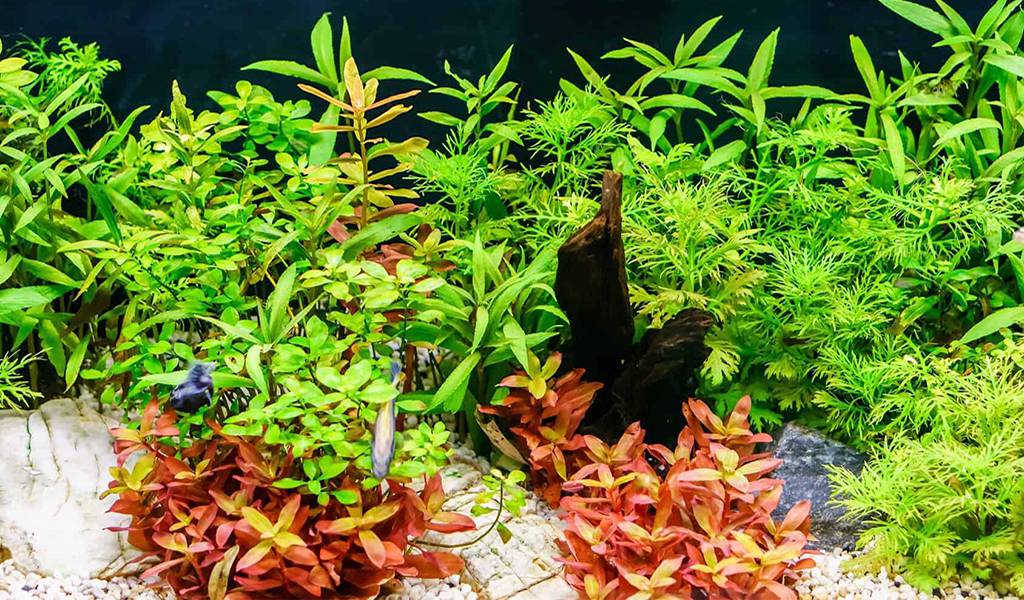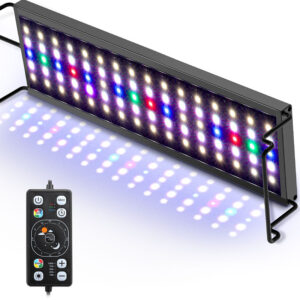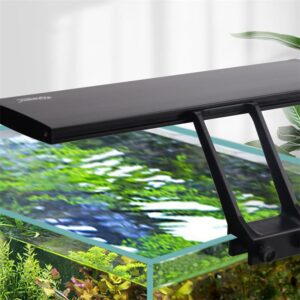Have you ever thought about whether your plants require light or not? Or how much light and how long do they need exactly? In this article, we will share the light settings for low-light plants and ways to limit their growth. Without further ado, let’s dive into the article!
Content Table

Do low-light plants need aquarium light?
Lighting plays a critically crucial role in the photosynthesis of plants, while it also becomes one reason for the thriving of algae. Nevertheless, seeing the unreasonable light, the plants’ color and growth will suffer, as well as the algae will flourish in tanks. In this part, we will provide you with how aquarium light influences the plants in aquariums.
The color of plants
Aquarium light is the most important factor affecting the color of plants. Only with suitable light intensity, plants of red or chromatic colors can possess brilliant colors. On the other hand, except for chlorophyll, plants also contain other pigments, such as anthocyanin and carotene. If there is subdued light, the proportion of chlorophyll will be promoted. And it enhances photosynthesis efficiency. On the contrary, in the case of extremely intensive light, the chlorophyll would be damaged by too much light. Since then, the production of photopigments, such as carotenoids, will increase, which will lead to bright colors of leaves, red leaves, for instance.
The growth of plants
In the face of unreasonable light, plants are usually eager to gain more light. They achieve this goal by growing taller so that they can be close to the surface of the water, then decrease the loss of light energy. Besides that, changing the morphology of leaves is another method. The limited light can not penetrate layers of mesophyll cells, hence the need for thin mesophyll tissue. Furthermore, the larger the leaves, the more light they get. Both ways are called “chasing the light”.
Although plants can gain more light by doing so, it is not worth happy. Since some plants can not show their original bright colors. Moreover, plants with tufted stems will grow high out of normal. Conversely, provided with high light, plants will be afraid of light and even want to get far away from it.

The thriving of algae
It is necessary to keep the living conditions stable in aquariums, including nutrition, light, carbon dioxide, and others. Consequently, plants can grow better and avoid the thriving of algae. However, frequent fluctuating in the living environment is not beneficial to plants, but good for algae, because of its great adaptability and flexibility. Furthermore, high light will lead to the thriving of algae.
In a word, plants need suitable light, varying from different types of plants. You should research the accurate requirements before making a decision. For example, Moneywort needs a light intensity of 2 watts per gallon and lighting time for 8 hours each day, while the Frogbit requires a light intensity of 2 watts per gallon at least and lighting hour for 8–10 hours per day.
Light settings for low-light plants
At present, you have known the necessity of light for plants. Soon, we will get into specific light settings for low-light plants. Just to be clear in advance, there are requirements for low-light plants in general:
- 3 or fewer watts of light per gallon of water in the aquarium
- 50–80 lumens per gallon of water in the aquarium
- 8–12 hours of lighting
In addition, you should also take the following factors into account.
Color Rendering Index (CRI)
A light source with a high CRI (Color Rendering Index) is an excellent choice for the better growth of plants. The CRI ratings of most light sources are over 90, and it will make the plants vibrant. Nevertheless, low CRI lights will lead to grayer colors of plants.
Wavelength
The table below shows the roles of different wavelengths (nm: refers to the range of wavelengths).
| Wavelength | Roles |
| 280-315nm | Affects morphology and physiology, but not badly. |
| 315-400nm | Reduce the absorption of chlorophyll and prevent the elongation of stems. |
| 400-520nm | Promote the absorption of chlorophyll and carotenoids and be beneficial for photosynthesis. |
| 520-610nm | Low absorption ratio of pigment. |
| 610-720nm | The low absorption ratio of chlorophyll and photosynthesis has bad effects. |
| 720-1000nm | The blossom of plants gets badly affected. |
| >1000nm | Convert to heat. |
Light Color
The great light colors are red, blue, and white. The ideal light colors for freshwater tanks are a combination of red and blue light. But for saltwater tanks, the combination of blue and white light is a better choice.

Color Temperature
The color temperature is another factor you should notice. It is presented on the Kelvin scale (“K”). 6500K is great for most plants in freshwater tanks, which are close to regular sunlight. As for saltwater tanks, 14000K is ideal.
PAR Value
The last one is PAR, whose full name is Photosynthetically Active Radiation. It measures the amount of light for photosynthesis. The best PAR value of low-light plants is 10-50 μmol/s. Accordingly, Hygger programmable light 20W would be a perfect option.
In summary, you’d better be sure about the tank’s size, species of plants, and their requirements in advance before you set the light. Only by doing so, you can set the best aquarium light for your plants.

Ways to limit the growth of aquarium plants
The appearance of plants will become less appealing for excessive growth. As a result, we need to limit their growth sometimes. We can limit the growth of plants by controlling the proportion of carbon dioxide in aquariums. Unfortunately, it is hard to measure and control carbon dioxide, thus, the method is not so feasible.
Besides that, we can also limit the growth of plants by adjusting the intensity of light. Not only it can limit the growth of plants, but also reduce the cost of lighting. Specifically speaking, light can accelerate the absorption of carbon dioxide and nutrition. On the other hand, light intensity is easy to control. We can achieve the goal by increasing or decreasing the number of bulbs and adjusting the positions of the lights. Also, we can use a timer to check the time of lighting. Most of the aquarium lights are programmable for lighting time, light color, and light intensity, you can go for the tutorial to program Hygger 999 aquarium light for your tank plants.
Reminder
Aside from the light settings for low-light plants, we are likely to recommend some low-light plants, such as Java Moss, Moneywort, Guppy Grass, Hornwort, and Sunset Hygro. If you want to learn more about low-light plants, it is doable to read another article – Easy Low Light Aquarium Plants For Fish Tank. Finally, we are hopeful about guiding you to set the light for low-light plants, and thanks for your reading!


Leave a comment